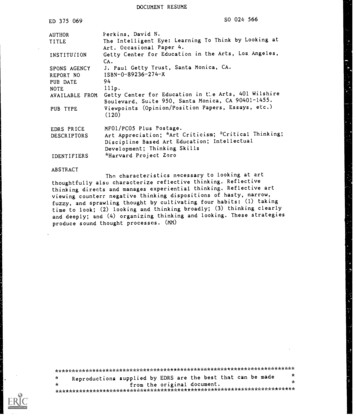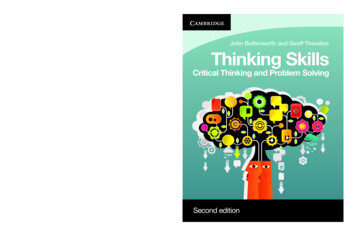
Transcription
Systems ThinkingWhole solutions for whole problemsDr. Colin J. NeillAssociate Professor of Software EngineeringAssistant Division Head, Engineering
Systems Thinking"Systems thinking is a discipline for seeing wholes. It isa framework for seeing interrelationships rather thanthings, for seeing patterns of change rather than static'snapshots'.Today systems thinking is needed morethan ever because we are becoming overwhelmed bycomplexity."Peter Senge, The Fifth Discipline
Emergent Properties Nature does not show us isolated building blocks,but rather a complex web of relationships betweenthe parts of a unified whole. The importance of each component of a system istied to its relationship to the whole and the essentialproperties of a system are properties of the whole. By looking at just one component in isolation wewould not have realistic picture of its importance We term this systemic properties, emergentproperties. The vehicular potential of a bike only applies to its whole,not its parts.
Systemic not systematic The power of systems thinking comes from a focuson systemic structures which is where the greatest leverage for problem solvingand positive change lies. A systems approach can help shed light on currentproblems especially those that seem to continually repeat - by viewingthem from a different perspective. Systems thinking offers a range of tools for gainingdeeper insight into problems from simple causal-loop diagrams and systems archetypesto more complex computer simulation models.
The World through a filter We interpret newly encountered things,situations and events in terms of ourprevious knowledge When the Spanish conquistadores arrived inMexico the indigenous people, unfamiliar withhorse riding saw the riders dismount and thoughta new creature had arrived on their shores thatcould separate itself in two at will.
It’s all perception What golf is to you? A game, frustrating, a good walk ruined, a drain on naturalresources and the ruin of natural habitats, exercise, stressrelief, stress inducing, marriage savior, marriage destroyer. What your car is to you? Environmental disaster, killing machine, a money pit,transportation, fun, thrilling, a taxi, pride and joy. What jail means to you? Punishment, rehabilitation, protection of society, trainingcamp for criminals, worse than death, taxpayer’s burden, anecessity, inhumane, a deterrent, a gym.
Fresh perspectives
Hard and soft systems Hard systems: Well-defined with clear objective and hence, a clear“means-end” solution. E.g. A payroll system - many elements, but well-definedrelationships, and therefore solvable. Soft systems: Poorly defined, unclear objectives so has no “class” ofsolution. Often referred to as “wicked” problems Actually most systems!
Soft Systems Soft systems exhibit emergent (unexpected, counterintuitive)behavior because of complex feedback loops among systemcomponents. And we find that: Organizational goals are a matter of controversy We assume that all members of an organization accept goals set bytop management, but this is usually not the case. Standard methods usually begin with a problem statement. But, fixing the problem too early means we are unlikely to seedifferent, possibly more basic, problems. The method itself restricts what can be found out; if we expect an organization to be describable by the interactionamong a number of clearly bounded subsystems then that will happen– we will see in the organization a reflection of our methods
The Fifth Discipline Systems thinking is necessary in business aswell as engineering. Every problem we face is multi-faceted, interrelated, non-intuitive and time-delayed so thatcause and effect are unclear. Peter Senge called it the Fifth Discipline
Some laws of the 5th Discipline Today's problems come from yesterday's solutions. The harder you push, the harder the system pushesback. Behavior grows better before it grows worse. The easy way out usually leads back in. The cure can be worse than the disease. Faster is slower. Cause and effect are not closely related in time andspace.
Today's problems come fromyesterday's solutions Often we are puzzled by the causes of our problems;when we merely need to look at our own solutions toother problems in the past. A well-established firm may find that this quarter's sales areoff sharply. Why? Because the highly successful rebateprogram last quarter led many customers to buy then ratherthan now". Furthermore, solutions that merely shift the problemto another sector will often go undetected becausethe people who “solved” the problem aren’t the oneswho inherit the new problem.
The harder you push, the harder thesystem pushes back This refers to the idea of compensating feedback. It turns out that even our best efforts to redesign orimprove a process often call forth responses (fromthe system) that offset the benefits of theintervention. Invariably, it seems that the more time and effort that isspent, the more time and effort that is required. “When our initial efforts fail to produce lastingimprovements, we “push harder” . . . all the whileblinding ourselves to how we are contributing to theobstacles ourselves.”
Behavior grows better before it growsworse Low-leverage interventions often work in theshort-term before their real effects are feltand the problem gets worse. This is akin to treating symptoms rather thanthe disease. We get relief from those painfulsymptoms while the disease grows andspreads.
The easy way out usually leads back in “We all find comfort applying familiar solutions toproblems, sticking to what we know best.” Those who push harder and harder with familiarsolutions while failing to change the fundamentalproblem are demonstrating nonsystemic thinking.Senge characterizes this as the “what we need hereis a bigger hammer” syndrome. We should seek to do the right thing, not the easything.
The cure can be worse than thedisease “Sometimes the easy or familiar solution isnot only ineffective; sometimes it is addictiveand dangerous.” The most insidious consequence ofnonsystemic solutions is the ever increasingneed to apply more and more of the solution.
Faster is slower “For most US business people the best rateof growth is fast, faster, fastest. Yet, virtuallyall natural systems have intrinsically optimalrates of growth. The optimal rate is far lessthan the fastest possible growth.” When growth becomes excessive the systemwill seek to compensate by slowing down . . .and that could put the organization at risk.
Cause and effect are not closelyrelated in time and space “The root of the difficulties is not recalcitrantproblems or evil adversaries, but ourselves.It’s the mismatch between the true nature ofthe reality in complex systems and ourthinking about that reality.” The first step in correcting that mismatch is tolet go of the notion that cause and effect arerelated closely in time and space.
But why? Structure influences behavior Structure in human systems is subtle Leverage often comes from new ways ofthinking
Structure influences behavior “Different people in the same structure tendto produce the same results. When there areproblems it is easy to find someone orsomething to blame. But, more often than werealize, systems cause their own crises, notexternal factors or individuals’ mistakes.”
Structure in human systems is subtle "We usually don't see the structures at playmuch at all. We just find ourselves feelingcompelled to act in certain ways." cause and effect not closely related in time andspace small changes producing big results from the systems perspective, the human actor ispart of a feedback process. We are continuallyboth influenced by and influencing our reality
Leverage often comes from new waysof thinking Reject linear cause-and-effect thinkingReject who-is-to-blame thinkingNote hidden balancing processesNote hidden processes that reinforcethemselves
Causal loop diagrams Rather than thinking in terms of linear causalrelationships, think of circular causal relationships.From To
Reinforcing and balancing feedback Reinforcing feedback processes are engines of growth.Reinforcing patterns can also accelerate decline – a pattern ofdecline where small drops amplify themselves into larger andlarger drops. Balancing feedback operates whenever there is goal-orientedbehavior – a target, either explicit or implicit.
Delays – between cause and effect We can show delays in the feedback, andthese lead to instability and oscillation
Systems Archetypes Patterns, expressed as feedback loops, thatdescribe common organizational behavior. Limits to GrowthShifting the BurdenEroding GoalsEscalationSuccess to the SuccessfulTragedy of the CommonsFixes that FailGrowth and UnderinvestmentAccidental AdversariesAttractiveness Principle
Limits to growth Something always pushes back. There is no suchthing as unrestricted positive reinforcing behavior.There are always limits that eventually makethemselves known and felt.
References P. Checkland. Systems thinking, systems practice.John Wiley. 1999. P. Checkland, & J. Scholes. Soft systemsmethodology in action. John Wiley. 1999. P. Senge. The Fifth Discipline: The art & practice ofthe learning organization. Doubleday. 1990. G.H. Watson. Business systems engineering:Managing breakthrough changes for productivity andprofit. John Wiley, 1994.
Systems Thinking "Systems thinking is a discipline for seeing wholes. It is a framework for seeing interrelationships rather than things, for seeing patterns of change rather than static 'snapshots'.Today systems thinking is needed more than ever because we are becoming overwhelmed by complexity." Peter Senge, The Fifth Discipline










